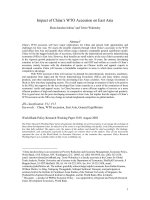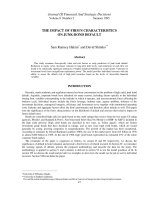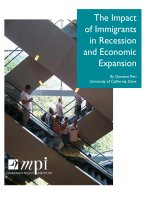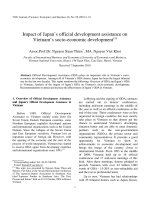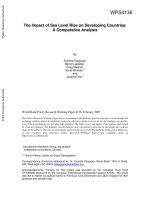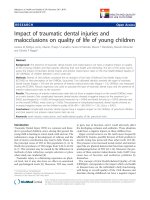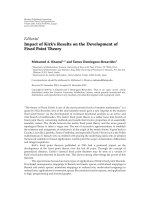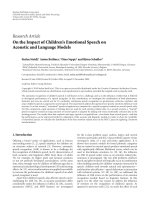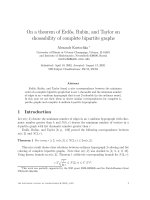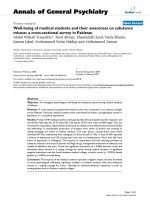Impact of Information Technology on Organizational Performance A Comparative Quantitative Analysis of Pakistan’s Banking and Manufacturing Sectors.
Bạn đang xem bản rút gọn của tài liệu. Xem và tải ngay bản đầy đủ của tài liệu tại đây (1.58 MB, 44 trang )
2008 Oxford Business &Economics Conference Program
ISBN : 978-0-9742114-7-3
Impact of Infor m ation Technology on
Org anizational Perfor m ance: A
Comparative Quantitative Analysis of
Pakistan’s Banking and Manufacturing
Sectors.
Muhammad Shaukat, Assistant Professor, Institute Of Management Sciences, Bahauddin
Zakariya University Multan (Pakistan). Email:
Prof. Dr. Muhammad Zafarullah, Vice-Chancellor, Bahauddin Zakariya University
Multan(Pakistan). Email:
Prof. Dr. Rana Abdul Wajid, Director, Centre for Mathematical and Statistical Sciences,
Lahore School of Economics, Lahore(Pakistan). Email:
Key Words: Information Technology, Organizational Performance, IT in Banking and Manufacturing sectors
Abstract
One of the major developments which had profound impact on the economic growth
pattern in the world in the new millennium has been the strides in the domain of
Information Technology sector. The world has observed significant growth of applications
in diverting areas of Information Technology. Information Technology has permeated
nearly every aspect of modern business operations and communications. This technology
really has drastically changed the working of today’s organizations and is being used both
by developed and developing countries for performance improvements. Similar to other
developing countries, this technology is also being applied in all the organizations of
Pakistan. Information Technology is also one of the most exciting areas of research that has
been the focus of intense interest throughout the globe over the decades but little has been
devoted to examining the impact of Information Technology on Pakistani organizations.
This study examines the impact of IT on organizational performance in quantitative terms
of Pakistan’s manufacturing and banking sectors over period of 1994-2005. The primary
data was collected through in-depth interviews, official documents and field surveys of 48
companies, 24 in manufacturing sector(12 local and 12 foreign) and 24 in banking
June 22-24, 2008
Oxford, UK
1
2008 Oxford Business &Economics Conference Program
ISBN : 978-0-9742114-7-3
sector(12 local and 12 foreign). The data was tested by applying different statistical and
financial techniques. The results of the research have led to the conclusion that Information
Technology has positive impact on the organizational performance of all the organizations
but the banking sector performance outstrips the performance of manufacturing sector and
local banking sector of Pakistan dominate the scene by implementing world class IT
systems.
INTRODUCTION
Information Technology is a powerful force in today’s global society. The advent of
computers and Information Technology (IT) has been perhaps the single
massive drive impacting organizations during past few decades. Information
Technology or IT is revolutionizing all the living ways. No doubt, it has
given a new meaning to the word “Convenience”. Information Technology
has drastically changed the business landscapes and word “IT” has become
the “Catchword” of the modern life today. Information Technology has
become, within a very short time, one of the basic building blocks of
modern industrial society. The effective use of IT is an essential element of
competing in a fast-paced, knowledge based economy. Information
Technology is the major contributor to the progress of the developed
countries(Drucker, 1992; Lang,2002; Vasudevan,2003).
The developing countries are increasingly deploying IT to solve their developmental
problems by investing in it from their own sources as well as by borrowing from different
institutions(Odedra & Kluzer, 1998). Lending for IT by the World Bank has also been quite
pervasive and growing at six times growth rate of total banks’ lending. A study has shown
that the significant IT components were present in over 90% of all world bank’s lending in
developing countries(Harris & Davision, 1999). It is also estimated that total annual
worldwide expenditure on Information Technology (IT) probably exceeds 1.5 trillion US
June 22-24, 2008
Oxford, UK
2
2008 Oxford Business &Economics Conference Program
ISBN : 978-0-9742114-7-3
dollars per year and is growing at about 10% compounded annually (Anandarjan et al.,
2002).
Information Technology also creates a serious dilemma for management today. IT
innovations have the potential for changing the competitive game for any organization. On
the other hand, the size of IT investments put increasing pressure on managers to asses its
business value. One key to this dilemma is to improve the ability to measure and track the
impact of IT on productivity. Alongside, the seemingly inexorable rise in IT investment
during the last 20 years, there have been considerable uncertainty and concern about the
productivity and efficiency impact of IT being experienced in work organization. However,
in quest of improving efficiency and effectiveness the companies are making heavy
investments in Information Technology. These enduring magnitudes of investment in
Information Technology so has drawn attention of many researchers, managers and policy
makers to the impacts of IT on growth and productivity. The expectation was that increased
investment in IT would naturally lead to increase performance of organization. But despite
the massive investments in IT both in the developed and developing economies, the impact
of IT on productivity and business performance continued to be questioned (Wilcock, et. al,
1998). Despite hundreds of studies carried out, scholars remained deeply divided into two
groups which can be identified as “Productivity Paradox-IT has no impacts on
productivity”(Turner, 1985, Loveman, 1988,1994; Roach, 1988; Mitra & Cyaya, 1996;
Strassman(1997); Dasgupta & Sarkis(1999) etc.), and “Productivity Payoff-IT does
improve productivity” (Bender, 1986, Mody & Dahlman, 1992); Raheim & Pennings,
1987; Harris & Katz, 1991, Brynjolfsson, 1993, 1996, Brynjolfsson, & Hitt, 1994, 1997,
1998; Attewel, 1991; Karemer, et. al, 1994; Dewan & Kraemer, 1998, Quinn, et. al, 1994 ;
Ng, 1996, Weill, 1992, Mehmood & Mann, 1993).
The goal of every information systems, based in any organization is to improve
performance on the job and this performance efficiency is only achieved when IT is
accepted and used warmly by the concern employees in organizations (Venkatesh et al.,
2003). In their quest for development, many developing countries put great hope in use of
IT. Yet, the challenges of IT diffusion in these countries are by no means identical to the
June 22-24, 2008
Oxford, UK
3
2008 Oxford Business &Economics Conference Program
ISBN : 978-0-9742114-7-3
ones in the developed countries. The challenges faced by developing countries in
harnessing the full potential of IT are not really very different from those of that confronted
by the developed countries(Khan, 2003).
Information Technology now is the most
preferred choice of all developing and developed countries to upgrade their economies and
become competitive in the global market place. The IT based economies have streamlined
the most complex economies of the world and enhanced the productivity to the level where
an economy such as US has wriggled out of the entire trillion plus dollars national deficit
and turned into a surplus in recent years. The world economy now has moved from lowvalue basic industries to a fast paced high-value information based economy.
Motivation for this Study
The impetus for this research came from the main reason that in modern organizations
Information Technology is a key to competitiveness and economic growth. It has no doubt
the greatest influence on the global economy. Like other countries Pakistan has also
accepted this challenge of 21st century by making efforts in the development of Information
Technology. A decade ago IT had very little introduction in the country, but very soon with
the efforts both on private and government fronts the concept of IT has become very
popular with all Pakistani organizations. Pakistani manufacturing and banking industries
are the major users of IT products. The central thesis of the present study is to seek the
impact, which Information Technology has on organizational performance of Pakistani
companies working in above mentioned sectors.
Literature Review
Definition of the concept of Information Technology
Information Technology has been defined in various ways by different authors. Over the
years, IT has been conceptualized and measured differently by different researchers. The
majority of the authors, however, parallel Information Technology with computer systems.
June 22-24, 2008
Oxford, UK
4
2008 Oxford Business &Economics Conference Program
ISBN : 978-0-9742114-7-3
Frenzel(1999) for example defines IT as “Information Technology is the term that
describes the organization’s computing and communications, infrastructure, including
computer systems, telecommunication networks, and multimedia (combined audio, text,
and video) hardware and software”. Shelly et. al(2005) narrate that “IT includes hardware,
software, databases, networks, and other related components which are used to build
information systems” Many other researchers also have come up with the same idea and
say that “IT is the technology that supports activities involving the creations, storage,
manipulation and communication of information together with their related methods and
management applications” (Martin et al., 1999; Gupta,2000; Kendall & Kendall ,2000;
Chan, 2000; Poku & Vlosky, 2002). However, William & Sawyar, 2005 define Information
Technology as a general term that describes any technology that help to produce,
manipulate, process, store, communicate, and/or disseminate information. This definition
may be regarded as the comprehensive one, as it covers all aspects discussed by different
researchers and includes all the components and processes needed to carry out information
processing work in the organization. So it can be said that that IT concept came from a
merging of computer with telecommunications technologies, when computer and
communications technologies are combined, the result is Information Technology or
‘infotech’.
Information Technology Developments In Pakistan
The process of computerization in Pakistan started since 1957 when a company named
‘Packages Ltd.” started using computer for its work. Since then IT usage is increasing
gradually. Though in the beginning Pakistani government was slow in adoption and
diffusion of IT but now it is at forefront of all government priorities. In Pakistan, realizing
the global revolution in Information Technology, the government has liberalized its
policies with regards to hardware & software imports since 1985. The custom duties on
electronic goods were also reduced drastically, but the real quantum jump was experienced
in early 90s, which can be termed as IT revolution in Pakistan and satellite communication
technology was introduced. In 1991, 90% telephone lines were converted to digital. In
1995, Internet Service Providers (ISPs) started providing Internet facility to Internet users
June 22-24, 2008
Oxford, UK
5
2008 Oxford Business &Economics Conference Program
ISBN : 978-0-9742114-7-3
and now there are more than 132 ISPs in operation all over the country providing internet
facility to more than 3,000,000 users1.
It is all in 2000s, that the government started giving a lot of emphasis to IT sector. New IT
educational institutes are opened & IT professionals are hired to impart IT training in
universities. Nationwide IT seminars, forums, exhibitions and competitions are being
arranged to create IT awareness among the people. Computer as a subject have been
introduced in schools & colleges. Cyber Cafes are being opened to create awareness for
Internet use. Telephone network has been enhanced and in rural areas, telecommunication
facilities are provided through small exchanges and PCOs. By doing so links between
Pakistan & other countries have been improved significantly (Imam 2002).
Information Technology is now also being used in all government organizations. Now the
Government of Pakistan is taking all steps to make Pakistan an IT super power by adopting
IT as a national program so as to enable personal and national growth. The country’s
current ‘IT Policy and Action Plan’ intends to involve all walks of life, e.g., industry and
commerce, banking and insurance, finance, revenue, communication, media, human
resource development, defense etc.(Rehman, 2005).
The computerization in the country which was initially monitored by the Ministry of
Science & Technology(MOST), now is being managed by a separate ministry of
Information Technology since November 2002. This ministry is maintaining firmness and
viscosity with the policy and achievements made in the IT & Telecommunications sectors
since its inceptions and to cope with modern challenges and meeting requirements of the IT
and Tele-communications, the policy is regularly updated. Many other departments/
institutions like Electronic Government Directorate, Pakistan Computer Bureau, Pakistan
Software Export Board, Pakistan Telecommunication Authority, Computer Society of
Pakistan, Pakistan Software Houses Association (PASHA) 2 etc. are working side by side
the Ministry of Information Technology to help forward IT in the country. To provide
1
2
www.moitt.gov.pk
PASHA is a representative body of software developer of Pakistan. It was found in late 1992 by 9 software
hoses and now have about 350 members national wide: www.moitt.gov.pk
June 22-24, 2008
6
Oxford, UK
2008 Oxford Business &Economics Conference Program
ISBN : 978-0-9742114-7-3
protection and enhance the confidence of users, providers and facilitators of information
services, legislation based on the recommendation of the working group comprising IT and
legal experts have been framed. Action in the area of digital signature act intellectual
property and copy right act and the consumer protection act has been started.(Kazmi,
2005).
According to some estimates, in Pakistan presently there are around 2,100 mainframe and
minicomputers in the country with nearly half of them being in the government sector.
Liberal import policy and reduction/removal of duties has led to a burgeoning usage of PCs
and servers (Osama, 2005). It is estimated that nearly half a million PCs are added each
year, representing a three fold increase in annual volume over the decade straddling the 21 st
Century. Analysts estimate that this rate of growth could very well quadruple by 2010. The
Federal Government of Pakistan has laid great emphasis on expedition towards the
intensity of Information Technology in a variety of fields. (Ghauri, 2003; Pasha, 2005).
To conclude all efforts of the government it can be said that the Government of Pakistan
now is giving all-out support and push to IT sector. Millions of dollars are being invested
by the government in IT, and majority being spent on human resource development and
enabling infrastructure provision. The Government of Pakistan is leading the technology
revolution in the country in various projects aimed at improving infrastructure, human
resource development and integrating IT in the public and private sector (Kazmi, 2000).
Information Technology And Pakistan’s Banking Industry.
Financial sector appears to be a clear leader in the growth of IT. It was among the first to
incorporate electronic data processing in its operations, through check handling,
bookkeeping, credit analysis and ATMs. Mayer(1987) while narrating the history of
computer usage in banking demonstrates that the use of computers in banking first began in
the early 1950s, when the first large commercial computer was built for Bank of America.
Initially, computers were used to process check transactions through magnetic ink character
recognition. With the introduction of first automated clearing house in the early 1970’s
electronic funds transfer (EFT) was made possible, and then ATM was introduced.
June 22-24, 2008
Oxford, UK
7
2008 Oxford Business &Economics Conference Program
ISBN : 978-0-9742114-7-3
Automated Teller Machine (ATM)3 is one of the most significant technological
investments made by the commercial banks. ATM’s introduced the power of computer
technology to the general public and made banking convenient for consumers. Today,
ATM’s deliver banking service 24 hours a day, 7 days a week to more than 22 millions
peoples only in USA.
The banks increasingly have turned toward ATM and other
computer technology like prepaid cards, loyalty cards, debit cards and even chip cards, to
reduce the high costs associated with maintaining traditional “brick and mortar” branches
staffed by tellers Koepp(2000). Franke(1987); Martini(1999). Now the banks are using
Information Technology in back-office (check and accounts) processing, mortgage and
loan application processing, and the electronic funds transfer to more strategic innovations
such as automated teller machines and new kinds of securities (Nsouli,2002).
The financial sector in Pakistan can be grouped into banking and non-banking financial
institutions (NBFIs). Banking institutions include large public sector scheduled banks,
private sector banks and foreign banks, while NBFIs include development finance
Institutions (DFIs), private sector investment banks, leasing companies and modarbas. The
banking industry in Pakistan has seen great transition during fifty-nine years of his history,
especially since early 1970s. The banking nationalization in 1974 and then privatization
and liberalization in early 1990, are termed as major restructuring years of the entire
banking industry of Pakistan. At the time of inception of Pakistan in 1947, only few bank
branches existed in the country, which were concentrated mainly in the urban areas.
Moreover, Pakistan was without a central bank of its own till June 30, 1948. However, by
early 1990s the banking sector had spread to every nick and corner of the country.
The market for banks is diverse in Pakistan comprising Nationalized Banks, Private Banks
and Foreign Banks. In 1993 there were 33 commercial banks in Pakistan 14 being local &
19 foreign. By the end of 2001 due to government liberalization policy to setup a private
bank, the number has increased to 43, 24 being local & 19 as foreign. But by the end of
2005, with some mergers there were 38 commercial banks 14 being foreign and 24 being
local. Total number of scheduled banks branches stood at 7,075 as on 30 th September,
3
Don Wetzel developed ATM in 1973 and it was first installed at Chemical Bank in New York (Shelly et.
al(2004) pp5.39.
June 22-24, 2008
8
Oxford, UK
2008 Oxford Business &Economics Conference Program
ISBN : 978-0-9742114-7-3
2005. There is a phenomenal progress in banking sector of Pakistan. It recorded an
increase of 99% growth in profit in only one year i.e 2005 4. NBP, HBL, MCB, ABL,UBL
are considered five large banks and are very dominant in the banking industry , in term of
total number of branches, deposits and advances, collectively accounting for 78% and 77%
of total deposit and advances respectively. Most of the local banks are in private sector
now, and many of them have started business since 1992 5. The introduction of computer in
banks in Pakistan started in 1965 when the main commercial banks in private sector i.e.
Habib Bank, United Bank and Muslim Commercial Bank started acquiring computers to
regulate their banking work. Since that time there is a massive investment in IT in banking
sector (Akhtar, 2006). This is bore out by the fact that during fiscal year 2003-2004, over
US$ 200 millions was invested by the financial services sector into Information
Technology products and services6. Shafiq(2002) says that not only this but also the
banking sector has dramatically increased its dependence on use of IT, and it is evident by
the growth in the number of branches that are connected online. In Pakistan almost all
national and multinational banks are using Information Technology to increase their
performance. Most of the Pakistani banks (local and foreign), have launched their web
sites and have uploaded many things on web including accounts opening forms and loan
applications. Likewise, the number of Automated Teller Machines(ATMs) and the use of
automated cheque clearing and other back end systems within the banking community
have increased7.
There have been great advances in Pakistan banking technology in the past several years.
The most recent automated banking systems like Misys, Sibel, and Fidility etc are being
installed in many of the Pakistani banks. Kazmi(2004) points out that most of the banks
operating in Pakistan however, have been making huge investments in three key areas
namely 1) expansion of the branch network 2) up gradation of the existing infrastructure 3)
adaptation of the new technologies with their ultimate objective is to offer a complete
4
The daily Dawn: “Banks profit grew 99pc in 2005”, Tuesday March 21, 2006. pp9.
Mahmood Javed (2006) “Another productive year for Banks” Money Plus July 17,2006.
5
Pakistan banking infrastructure statistic: State Bank of Pakistan’s report 30-09-2005.
6
7
“Status Of IT Industry Of Pakistan, The Dawn, 28th February, 2005.
Approximately 2174 ATMs have been installed by different banks till May 2007 in different cities of
Pakistan (The Dawn, June 22, 2007). Out of Total 7674 Branches, 4091 (53%) are Online. Jang 31-5-2007
June 22-24, 2008
9
Oxford, UK
2008 Oxford Business &Economics Conference Program
ISBN : 978-0-9742114-7-3
electronic banking facility. Table 1 presents a real picture of E-Banking infrastructure
statistic of Pakistan till September 2005. Ahmed(2003) posits that the huge investments by
the commercial banks in technology has ushered a new era of convenience and improved
quality of services in Pakistan. The banks are offering Internet and mobile banking but it
has not made major impacts yet. In the end to mention another big achievement in payment
area is RTGS setup by State Banks of Pakistan for interbank settlement.
June 22-24, 2008
Oxford, UK
10
2008 Oxford Business &Economics Conference Program
Table 1
June 22-24, 2008
Oxford, UK
11
ISBN : 978-0-9742114-7-3
2008 Oxford Business &Economics Conference Program
Information Technology
Industry.
ISBN : 978-0-9742114-7-3
And Pakistan’s Manufacturing
Automation in manufacturing organizations goes back to 1900. Around the year 1900,
factory mechanization facilitated mass production to meet the consumers’ demands for
improve products. In the year 1930, transfer lines and fixed automation were created to
facilitate mass production. This resulted in the development of programmable automation.
By the year 1950, numerical control (NC) was developed as an innovative approach to
programmable automation. With the development of commercially available computer
technology, the application of computer in manufacturing started to emerge by producing a
variety of new technologies. By the year 1955, the introduction of computer aided
design(CAD) and development of NC resulted which lead to the evolution of system like
computerized numerically controlled machine tolls (CNC). By the year 1970, development
in CAD applications and Computer Aided Manufacturing (CAM) based systems, Computer
Aided Engineering(CAE),Material Resource Planning(MRP), Flexible Manufacturing
Systems (FMS),which are collectively named as AMTs-Advanced Manufacturing
Technologies was made(Negalingam and Lin, 1999). AMT provided flexibility as well as
data driven computer integration for a manufacturing organization, in which the
manufacturing technology utilized is intelligent enough to urge forward the activities with
less human interventions. Industrial robots, automated guided vehicles, and automated
storage and retrival systems are also introduced. These applications can be connected via
Local Area Networks(LAN) to from computer Integrated Manufacturing(CIM) and
externally, across organizations and space, via Electronic Documented Interchange (EDI)
(Sohal, 1999).
The technology advancement in the world over is so rapid and wide spread that isolates
manufacturing and technology from each other is merely an impossible proposition.
Information Technology is becoming critical to many manufacturing organizations that
want to be a world-class manufacturer as IT often provides a manufacturing based
advantage. Information Technology can assist manufacturing firms in developing their
strategic roles. In today’s competitive global market, for the survival of any industry,
manufacturing companies need to be pliable, adaptive, responsive to change, proactive and
June 22-24, 2008
Oxford, UK
12
2008 Oxford Business &Economics Conference Program
ISBN : 978-0-9742114-7-3
be able to produce a variety of products in short time at a lower cost (Ho, 1996). Hence,
manufacturing companies are compelled to seek advanced technologies by integrating
manufacturing facilities and systems in an enterprise through computers, its peripherals and
communication network to transform island of enabling technologies in to a highly
interconnected manufacturing systems. Today, the capability of producing high quality
products according to diverse customer requirements with short delivery times has become
the characteristic of order-qualifiers for manufacturing industries. Furthermore, non price
factors, such as quality, product design, innovation and delivery services are the primary
determinants of product success in today’s global arena(Shaw, 2000). Implementing
integrated advanced technologies is an effective approach towards solving the problems of
decreased productivity, labor cost and consequent rise in unit costs, which are continually
plaguing present day manufacturing manager. Implementing advanced manufacturing
technologies (AMTs) provides opportunities to achieve competitive advantage in an
intermediate-to long-term time frame (Sohal, 1999). The Internet based distributed systems
motivated the industries to utilize IT in all areas. Advances in software technologies have
been transforming the world of integration into compatibility systems and devices by
establishing an open connectivity standards, agreed by the manufacturers, which will
provide plug-and-play communication and interoperability between field devices, control
systems, and enterprise wide business applications(Kumar, et. al, 2004).
Pakistan industrial sector remains a relatively small part of the total economy. Pakistan’s
manufacturing sector has grown rapidly but remains inefficient and lacks diversification. In
practice, Pakistan’s industrialization process has largely been governed by trade and tariff
policies which are driven by revenue and/or balance of payments considerations rather than
by a coherent industrial policy framework (Kemal, 1999). Overall manufacturing is
growing at a much faster pace than agriculture and services and if this pace is sustained, its
share in GDP is likely to rise further in the medium term 8. Various factor including
accommodative monetary policy, financial discipline, consistency and continuity in
policies, strengthening of domestic demand is continuously improving to improve
contribution of manufacturing sector. In Pakistan both large-scale, multinationals, local and
8
Pakistan Federal Bureau Of Statistics, 2004.
June 22-24, 2008
Oxford, UK
13
2008 Oxford Business &Economics Conference Program
ISBN : 978-0-9742114-7-3
small scale domestic and international companies are operating which are producing goods
of almost all kind (Saeed, 2003).
Revolutions beget openings of one kind or the other. The IT revolution would semblance to
have opened a beneficial window of opportunity for the Pakistani manufacturing
organizations. After that many other companies in this sector started using computer to
increase their productivity. Now IT usage in manufacturing and industrial sector is very
common. Within the industrial sector, the use of Enterprise Resource Planning software
packages such as SAP and Oracle have become commonplace. 9(Rizvi, 2005; Shahid, 2005;
Mujahid, 2003).
Organizational Performance
The performance as stated by Wheelen and Hunger(2000) is an end result of an activity and
an organizational performance is accumulated end result of all the organization’s work
process and activities. Managers measure and control organization performance because it
leads to better asset management, to an increased ability to provide customer value, to
improve measures of organizational knowledge and measure of organizational performance
do have an impact on an organization’s reputation. When the performance of the
organization is assessed, the past management decisions that shaped investments,
operations and financing are measured to know weather all resources were used effectively,
weather the profitability of the business met or even exceeded expectations, and weather
financing choice were made prudently. The most frequently used organizational
performance measures include organization efficiency(productivity), organizational
effectiveness and industry ranking (Wetherbe,1999; Turban, et al, 1999 & 2001). As this
paper focuses on measurement of efficiency and effectiveness part of organizational
performance, therefore, these concepts are elaborated in detail.
In the academic literature efficiency is defined by many ways, Witzel(1998) for example
looks at the origin of the term and finds that it has two meanings: technical efficiency or
ensuring that systems and process work to their optimal level, and total efficiency, or
ensuring that the organization as a whole is fit to meets its goals. Edwards(2001) says that
“Efficiency is minimum utilization of resources and getting maximum output”.
9
Report from Federal Ministry Of Industries, 2004.
June 22-24, 2008
Oxford, UK
14
2008 Oxford Business &Economics Conference Program
ISBN : 978-0-9742114-7-3
Druker(2002) defines efficiency as “It is doing job successfully without wasting time or
energy. While defining effectiveness Hosmer(1982) says that “Effectiveness means how
well the job gets done”. McClenahen (2000) defines effectiveness in a way that “It is extent
to which an organization realizes its goal”. Oz (2002) defines effectiveness, as “It is the
degree to which a goal is achieved”.
According to Robbins & Coulter(2002)
“Effectiveness is “doing the right things” to achieve organization goal.
Measuring Impact Of Information
Organizational Performance.
Technology
On
As Walrad & Moss(1993) state that efficiency and effectiveness do not means the same
thing. In fact, they are often natural enemies. Often one can have one, or the other,
but not both (Unless one is lucky or one want to spend a lot of money). Being
efficient means that one spends less time on something, one spends less money on
something or one spends less efforts (or number of workers) on something. Being
effective means that one does his job well. In other words, the output (finished
product) is of high quality. It is a rare and delightful occasion where a solution to a
problem is both efficient and effectiveness; one usually has to decide which he
prefers, because one usually cannot have both. Maggiolini(1999) rightly assessed that
efficiency and effectiveness are entirely unrelated, so as their measurement.
In an IT context when we measure the effectiveness, we basically measuring the capacity
of the outputs of information systems or of an IT application to fulfill the requirements of
the company and to achieve its goals, making this company more competitive. In the same
IT context the efficiency is the measurement that how cheaply can you get things done, and
are the people to whom you provide IT services (the stakeholders) happy with the levels of
service being delivered? and does it reduced the operational expenses?.
Various studies have been undertaken to measure the impact of IT on management
performance (efficiency & effectiveness) of business organizations using different
performance indicators which according to Dyson(2001) are considered key factors. These
variables capture all activity levels and performance measures and common to all units and
June 22-24, 2008
Oxford, UK
15
2008 Oxford Business &Economics Conference Program
ISBN : 978-0-9742114-7-3
cover the full range of resources used. These variables include income, customer
satisfaction, supplier/customer links, company image, job interest of employees, stake
holders confidence, interoffice links. Researchers like Huber(1996), Parthasamthy and
Sethi(1993),
Kelly(1994),
Earls(1996),
Rumizen(1998),
O’Dell(1999)
etc.
have
investigated the impact of IT on incomes/profits of the companies and found positive
impact. Whereas, Farkline(1997), Marton and Chester(1997), Olalla & Fassas(2000),
Schmidtel et. al(2001), Zee(2004) etc. have seen the increase/decrease in above qualitative
factors after implementation of IT. They have concluded that IT has ultimately increased
company image, job interest of employees, stake holders confidence, interoffice link etc.
This study measures the organizational performance in respect of increase/decrease in
income/profits and no of employees of Pakistani companies operating in banking and
manufacturing sectors with relation to IT implementation.
Research Propositions
The Sample
There are two population groups for this research. One is the banking sector local and
multinational and the other is large manufacturing organizations again both local and
multinationals, which are making use of Information Technology. The reasons to select the
above-mentioned sectors are that; 1) the banking sector of Pakistan is the most organized
sector of the service industry and highly IT user 2) this sector has made much more
investments in IT than any other sectors to achieve high performance 3) IT has met greater
introduction in banking sectors for performance improvements since 1992 because of throat
cut competition after establishment
of many new banks in the private sector
and
privatization of many nationalized banks. The second sector of study i.e. manufacturing is
the next best user of Information Technology. A large number of local and foreign
manufacturing companies working in Pakistan are using IT for their business processes
since long. Many companies in both the sectors have state-of-the-art technologies for
improving their performance. The management of these organizations has also made
numerous investments in I.T with the hope to increase their efficiency.
June 22-24, 2008
Oxford, UK
16
2008 Oxford Business &Economics Conference Program
ISBN : 978-0-9742114-7-3
In the sample from the above sectors 48 companies, 24 in banking sector (12 foreign, 12
local) and 24 in manufacturing sector (12 foreign, 12 local) were taken. List of sample
companies is given in Annexure II. There are about 40 commercial banks operating in
Pakistan. Out of these 40 banks, 24 banks are included in the sample because of the reasons
that many other banks are either set up in few years back or do not have well established
network in Pakistan, therefore, they do not serve the purpose of this research. There is no
definite information available relating to the size of large manufacturing sector. It is
estimated however that about 2000 large-scale manufacturing units are operating in
Pakistan. Therefore, in the sample, from the manufacturing sector, a total of 24 big
organizations were randomly included. The sample size could have been increased but the
nature of problem seems to be similar in each case. So the chosen sample size is considered
to be sufficient. The companies selected are using latest Information Technology and have
well established IT set up.
Data Collection
The participants in the study were categorized as follows; the senior managers of finance,
human resources, marketing and IT departments of the companies in sample. The data was
collected from in-depth interviews using a structured close-ended questionnaire, and from
official documents, detailing different aspects pertaining to the study. During the process of
data collection, follow-up letters and telephone calls were also made to the respective
company.
Data Limitations
In this research the research problem has been analyzed for the last decade i.e. from 1994
to 2004, because of the reasons that many companies operating in Pakistan were either not
using IT before 1994 or IT had very little introduction and computers were being used
merely as a word processing tools. So it was difficult to measure any of significant IT
impact on management performance before above period. Most of the companies initially
declined to provide any financial(IT expenses and Income) data citing confidentiality and
busy schedules as reasons. However, by help of SBP and SECP, the researchers managed
to collect some data in one year period from these companies. Therefore, Income & IT
June 22-24, 2008
Oxford, UK
17
2008 Oxford Business &Economics Conference Program
ISBN : 978-0-9742114-7-3
expense analysis for test of hypothesis is limited to those companies and for those years for
which the data is received. So for analyses of Income Vs IT expense, the companies are
divided into two groups as given in Table 2 & 3 below. The response rate for data was
42% for the year 1990-2004 and 67% for the year 1999-2004.
Table 2: Group 1: (Companies for which data was available for year 1990 to 2004
Data
A.
ForeignAnalysis
Banks
Methods:
B. Local Banks
1. ABN Amro
1. Allied Bank Ltd.
The2. statistical
software packages named SPSS
12.0 and Minitab 14.0 have been used for
Bank Of Tokyo
2. Bank Of Punjab
3. Deutsche
Bank
3. First Women
Bank Ltd.
analysis.
According
to the problem/requirement,
statistical
techniques such as linear
4. HSBC Bank
4. Muslim Commercial Bank Ltd.
regression
model, t-test, One Way ANOVA
and ratio
have been applied. The
5. HBL AZ-Zurich
5. National
Bankanalysis
Ltd.
proceeding discussion presents the analyses/results of the hypothesis of the study with
C. Foreign Manufacturing
D. Local Manufacturing
conclusion
at theLtd.
end. The research hypothesis
stated
the beginning, is then taken as
1. I.C.I Pakistan
1. Atlas
HondaatLtd.
2. Pakistan
Tobacco Ltd.in the statement of statistical
2. D.G. hypotheses.
Cement
alternative
hypothesis
3. Suzuki Pakistan Ltd.
3. Lakson Tobacco
4. Simens Pakistan Ltd.
4. Service Industries
5. Uni Lever Pakistan Ltd.
5. Packages Ltd
Table 3: Group 2: In this group three more companies in each sector of group 1 are added and the
data is available for the years 1999-2004.
A. Foreign Banks
B.
Local Banks
1.
2.
ABN Amro
Bank Of Tokyo
1.
2.
Allied Bank Ltd.
Bank Of Punjab
3.
4.
Deutsche Bank
HSBC Bank Ltd.
3.
4.
First Women Bank Ltd.
Muslim Commercial Bank Ltd.
5.
6.
7.
8.
5.
6.
7.
8.
1.
2.
3.
HBL AZ-Zurich
Citi Bank
Standard Chartered Bank
Oman Bank Ltd.
Foreign Manufacturing
I.C.I Pakistan Ltd.
Pakistan Tobacco Ltd.
Suzuki Pakistan Ltd
1.
2.
3.
National Bank Ltd.
Askari Bank Ltd.
Bank Al-Habib Ltd.
Metropolitan Bank Ltd.
Local Manufacturing
Atlas Honda Ltd.
D.G. Cement
Lakson Tobacco
4.
5.
6.
7.
8.
Simens Pakistan Ltd.
Uni Lever Pakistan Ltd.
Bata Pakistan Limited
L.G Pakistan Limited
Reckitt Benkiser Limited
4.
5.
6.
7.
8.
Service Industries
Packages Ltd
General Tyre Ltd
Indus Mtors Ltd
Honda Atlas Ltd
C.
June 22-24, 2008
Oxford, UK
D.
18
2008 Oxford Business &Economics Conference Program
ISBN : 978-0-9742114-7-3
Research Hypothesis
This section examines the performance of both the sectors of economy i.e banking and
manufacturing in term of increase/decrease in net income and no of employees.
Increase/decrease in incomes has been observed for all companies in both the sectors and
for each conditions two different research hypotheses have been tested as under;
“Implementation of IT has impact on the performance of an organization”.
This can be translated in form of statistical hypotheses as:
H0: IT has no impacts on performance of the organizations.
H1: IT has impacts on performance of the organizations.
In order to test the above hypotheses, the performance of an organization has been
measured by measuring:
(a) Increase/decrease in net income, after implementation of IT.
(b) Increase/decrease in the proportion of IT employees as the IT is implemented.
June 22-24, 2008
Oxford, UK
19
2008 Oxford Business &Economics Conference Program
ISBN : 978-0-9742114-7-3
Time series data was available for these variables. Simple linear regression model was
fitted taking IT expenses and time as independent and income as dependant variables.
Summary of regression results are presented in Tables 4(a,b,c,d) to 5(a,b,c,d) and 6.
Results And Discussions
In the discussion below we examine the impact of IT on organizational performance by
performing the quantitative analysis of net income, IT expenses, total and IT employees. In
interpretation, results of each company are discussed separately then comparison has been
made between the Local & Foreign Banks, Local and Foreign Manufacturing Companies,
Banking and Manufacturing Sectors. The discussion is also made on all the companies
overall.
i) Banking Sector.
a) Foreign Banks: The regression analysis shows that IT has no impact on the
incomes of the Bank of Tokyo, Deutsche Bank and HSBC bank as p-values or marginal
significance levels for these banks are above 0.05. IT has positive impact on the
incomes of ABN Amro and Habib Bank AG Zurich as p-values or marginal
significance levels for both these banks are far below 0.05. All regression coefficients
are positive showing that with the increase in expenditure on IT, the incomes of these
banks have substantially increased. Analysis is also made for all foreign banks as a
whole for group 1 and group 2(Tabel 2 & 3). For both groups, it was found that IT has
significant positive impact on income of all foreign banks operating in Pakistan (pvalue < 0.05).
Regression Results Summary (α = 0.05)
For Banking Sector
Year 1990-2004
Table 4(a)
S/No
1
2
3
4
5
6
7
8
9
Bank Name
Results
β coefficient
t-Statistics
p-value
7.179
4.458
7.726
7.487
12.919
3.214
8.264
10.791
7.316
8.661
10.573
5.929
15.187
9.829
2.574
3.673
8.871
2.510
.000
.000
.000
.000
.000
.023
.003
.000
.026
All Banks : n=10
All Foreign Banks: n=5
All Local Banks: n=5
ABN Amro
HBL AG Zurich
Bank of Punjab
First Women Bank
Muslim Commercial Bank
National Bank of Pakistan
June 22-24, 2008
Oxford, UK
20
2008 Oxford Business &Economics Conference Program
Regression Results Summary (α = 0.05)
For Manufacturing Sector
Year 1990-2004
Table 4(b)
S/No
Company Name
1
2
3
4
5
6
7
S/No
t-Statistics
p-value
4.357
4.148
12.157
12.509
61.397
1.956
1.624
4.357
3.071
2.686
7.885
4.898
2.182
5.927
.000
.003
.019
.000
.000
.048
.000
Results
Company Name
All Companies: n=20
All Banking Sector: n=10
All Local Banks: n=5
All Foreign Banks n=5
S/No
Company Name
1
2
3
4
5
β coefficient
t-Statistics
p-value
0.02.798
0.04.57
0.03923
0.155
2.685
6.159
4.432
9.453
.008
.000
.000
.000
Regression Results Summary (α = 0.05)
For All Companies
Year 1999-2004
Table 4(d)
Results
β coefficient
t-Statistics
p-value
0.03496
0.04879
0.04024
0.09181
0.03068
4.258
7.903
4.953
10.714
2.680
.000
.000
.000
.000
.010
All Companies n=32
All Banking Sector n=16
All Local Banks n=8
All Foreign Banks n=8
All Local Manufacturing n=8
Regression Results Summary (α = 0.05)
For Banking Sector
Year 1990-2004
Table 5(a)
S/No
Bank Name
Results
β coefficient
t-Statistics
p-value
15.788
-.466
11.273
.288
2.128
-.172
1.405
.047
.053
.866
.184
.963
Bank of Tokyo
Deutsche Bank
HSBC
Allied Bank Limited
Table 5(b)
S/No
1
2
3
4
5
6
7
β coefficient
Regression Results Summary (α = 0.05)
For All Companies
Year 1999-2004
Table 4(c)
5
6
7
9
Results
All Companies: n=20
All Local Manufacturing: n=5
Atlas Honda
Lakson Tobacco
Suzuki
P.T.C
Siemens
1
2
3
4
ISBN : 978-0-9742114-7-3
Regression Results Summary (α = 0.05)
For Manufacturing Sector
Year 1990-2004
Company Name
Results
β coefficient
t-Statistics
p-value
.118
-.275
1.171
70.706
-.701
.496
-.960
.285
-.423
.374
1.869
-.112
.226
-.761
.776
.674
.715
.084
.913
.824
.460
All Manufacturing Companies: n=10
All Foreign Manufacturing: n=5
D.G. Cement
Packages
Service
I.C.I Pakistan
Uniliver Pakistan
Regression Results Summary (α = 0.05)
June 22-24, 2008
Oxford, UK
21
2008 Oxford Business &Economics Conference Program
For all Companies
Year 1999-2004
Table 5(c)
S/No
1
2
3
Company Name
S/No
1
2
Results
β coefficient
t-Statistics
p-value
-0.0153
0.01588
-0.03544
-.648
1.165
-1.210
.519
.254
.236
All Manufacturing Sector: n=5
All Local Manufacturing: n=5
All Foreign Manufacturing n=5
Table 5(d)
Regression Result s Summary (α = 0.05)
For all Companies
Year 1999-2004
Company Name
Results
β coefficient
t-Statistics
p-value
-0.005.53
0.001141
-.203
.073
.840
.942
All Foreign Manufacturing n=8
All Manufacturing n=16
Table 6
S/No
ISBN : 978-0-9742114-7-3
Regression Results Summary
For Total and IT Employees (n=20)
Year 1990-2004
Results
Organizations
t-Statistics
1
All Companies
20.886
2
All Banks
13.576
3
All Foreign Banks
-1.288
4
All Local Banks
13.953
5
All Manufacturing
16.565
6
All Local Manufacturing
12.428
7
All Foreign Manufacturing
17.500
Years: Independent variable IT Employees %age to Total Employees: Dependent variable
P-value
.000
.000
.220
.000
.000
.000
.000
As depicted in Annexure II, total no of employees in foreign banks have been
increased continuously from the year 1990 to 2004, despite of the facts that IT
has been applied in all operations of the banks. The IT has not reduced the
number of employees as anticipated by some circles due the reasons that most
of the banks in this sector have introduced new products or services during this
period, so the work load has increased therefore staff strength has also
increased. It has also been observed that there are floating trends in the
strength of IT employees. As Annexure II indicates that IT employees have
increased for years 1990-1993, decreased from 1994 to 1997 but again
increased from 1998 onwards and that
increase is due to increase in IT
activities because of raised volume of transactions, introduction of new
products/services and increasing competition with the local banks in offering
online/ computerized services. The net income for these banks for the years
June 22-24, 2008
Oxford, UK
22
2008 Oxford Business &Economics Conference Program
ISBN : 978-0-9742114-7-3
1990-2004 is PKR 11,429,932,000 and IT expenses are PKR 1,716,997,260
which comes to 15.02% of net income but net income for these banks for the
years 1999-2004 comes to PKR 18,616,763,000 and IT expense are PKR
2,460,082,000, which are 13.21% of net income.
b. Local Banks: It is revealed from regression analysis that IT has positive
impact on the income of most of the local banks i.e. Bank of Punjab, First
Woman Bank, Muslim Commercial Bank and National Bank of Pakistan (p-vale
or marginal significance level is far below 0.05). But IT has no impact on
income of one bank, i.e Allied Bank (p-value > 0.05). Overall it is also found that
IT has positive impact on income of all the local banks for group 1 and 2 as for
both groups (p-value <0.05).All regression coefficients are also positive which
shows that with the increase in expenditure on IT, the incomes of these banks
have increased significantly.
As shown in Annexure II, there has been decrease in total no of employees of
local banks. It is not because of IT but it is due to restructuring and privatization
of most of local banks. For right sizing purpose many employees were laid off
by offering ‘golden hand shakes’ schemes. Contrary, as also presented in
Annexure II, there has been gradual increase in the IT employees, due to
increase in workload for up gradation, computerization/making online of many
branches as per industry or customer need. Moreover, net income for these
banks for the years 1990-2004 is PKR 28,040,686,000 and IT expense are
4,185,681,800, with a ratio of 14.93%, whereas net income for these banks for
the years 1999-2004 is PKR 28,710,716, 000 and IT expenses are
4,479,494,500 with an increased ratio of 15.60%.
c. All Banks : Turning to the overall performance of all the banks for group 1 &
2, it is observed that IT has positive impact on the income of all these banks (pvalues< 0.05). A positive regression coefficient supplements our results that
June 22-24, 2008
Oxford, UK
23
2008 Oxford Business &Economics Conference Program
ISBN : 978-0-9742114-7-3
increase in expenditure on IT significantly increases the incomes of these
banks.
To further examine the performance, trend analysis for IT spending and net
income is carried out. It is noted that there is increase in income with
proportional increase in IT expenditure of all banks. Detailing it, the net income
for all the banks for the years 1990-2004 is PKR 39,470,618,000, IT expenses
are 5,902,679,060, which are 14.95% of net income. The net income for all the
banks for the years 1999-2004 for group 2 is PKR 47,327,479,000 and IT
expenses are 6,939,576,500, which are 14.66% of net income. While the net
income for all foreign banks for the year 1999-2004 is PKR 7,44,175,000 and IT
expenses are 1,050,855,000 which are 14.12% of the net income for the same
period, but these expenses are 61.20% of total IT expenditure out of the year
1990-2004. That means that the companies have been spending large amounts
during the last six years in their IT operations. The same case is for all local
banks i.e. the net income for all local banks for the year 1999-2004 is PKR
18,773,824,000 and IT expenses are 3,454,532,500 which are 18.40% of the
net income for the same period but these are 82.53% of total IT expenditure
from the year 1990-2004. That also shows that there are high increasing trends
in IT expenditures in local banks in the past six years (1999-2004). Surprisingly,
the same results are found for the entire banking sector i.e. the net income for
all the banks for the year 1999-2004 is PKR 26,213,999,000 and IT expenses
are 4,505,387,500 which are 17.19% of the net income for the same period but
these expenses are 76.33% of total It expenditure for the year 1990-2004. It
indicates that there is high increase in IT expenditures in the entire banking
sector during the year 1999-2004.
To investigate the linkage between the It expenditure and increase/decrease in
number of total and IT employees, we observed that during the sample period,
the number of IT employees have increased in the banking sector but total
employees have been decreased. Further, our regression analysis also shows
June 22-24, 2008
Oxford, UK
24
2008 Oxford Business &Economics Conference Program
ISBN : 978-0-9742114-7-3
(Table 6) that this increase has positive impacts on income (p-value < 0 0.05).
Table 7(a,b,c) and Graph 1 to 3
report the summary of net income/ IT
expenses and % increase/decrease of income to expense.
ii. Manufacturing Sector
a. Local Manufacturing Companies: The regression analysis shows that IT has
positive impacts on the incomes of the local manufacturing companies i.e Atlas
Honda and Lakson Tobacco (p-values < 0.05). But IT has no impact on the income
of D.G. Cement, Packages and Services Industries, (p-value > 0.05).
Further analysis for all local manufacturing companies for the years 1990-2004 and
1999-2004 shows that IT has positive impacts on income of all the local companies
as p-value is far below .05 for group 1 and 2 (Table 3 & 4). The regression
coefficient for these companies is positive, which indicates the decisive impact of
IT on income. At the same time, net income for these companies for the years
1990-2004 is PKR 14,118,508,000 and IT expenditures are 1,374,077,480 which
are only 9.73% of net income. Whereas, net income for the year 1999-2004 is
9,791,169,000 and IT expenses are 950,434,480 that are 9.71% of the net income
of 1999-2004 but 69.17% out of total IT expenditure of 1990-2004. For group 2 the
net income for these companies for the years 1999-2004 is PKR 16,455,436,909
and IT expense are 1,436,243,780 which are low as 8.73% of net income.
June 22-24, 2008
Oxford, UK
25
